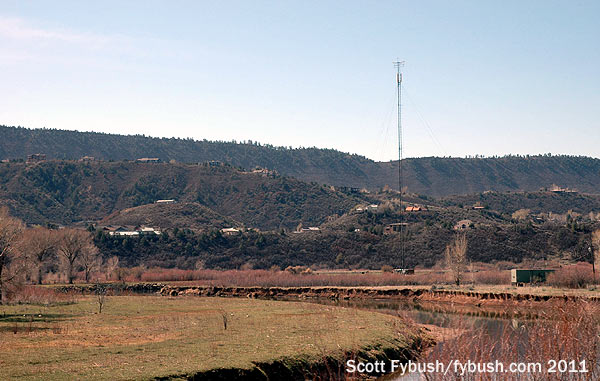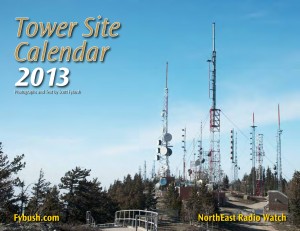NorthEast Radio Watch 12/8/2025: Cichon’s Back in Buffalo
In this week’s issue… Veteran newsman returns - Remembering NY's Leitner, RI's Jones - CT AM saved - Maine AM moves - "Indie" adds suburban signals
By SCOTT FYBUSH
When we were planning the excursion that became “Fairly Big Trip 2011,” we confess that we didn”t know very much about Durango, Colorado. Old mining town? Check. Somewhere near the Four Corners? Check. Home base for the Durango and Silverton narrow-gauge railroad? Most certainly. But beyond that, Durango was mostly a surprise – and what a pleasant surprise it turned out to be! This small city of just 16,000 or so people has a wildly vibrant restaurant scene and a wonderful funky Victorian downtown. Oh, and it has some neat broadcasting history, too.
Back to the train for a moment: the railroad is the entire reason this town is here. Durango was founded in 1881 as a stop on the Denver & Rio Grande Railroad, connecting a narrow-gauge line that was being built along the Animas River coming south from the mines around Silverton, in the mountains 45 miles north, with the narrow-gauge line heading eastward toward the more populated part of the state. The east-west line was largely abandoned by the 1960s, but the line up to Silverton survived as a tourist operation, and should you ever find yourself in this part of the world, please do not miss the opportunity to ride that line and experience its history and its mind-blowing scenery.
And should you do that, you”ll get to enjoy one bit of scenery that most of your fellow passengers won”t notice. As you”re heading north out of the Durango depot, just before the northern fringe of Durango starts to fade away into ranch land and then into the mountains, look to the east just across the Animas and you”ll see a tower just a few hundred yards from the tracks. Today, this tower is home to both of Durango”s AM stations, KIUP (930) and KDGO (1240).

KIUP and KDGO have been competitors for as long as they”ve both been on the air in Durango, but they”ve only been co-located at this site (featured in Tower Site Calendar 2013!) since about 1997.
KIUP is the older station in town, and it has the more interesting history, too. It was founded in 1935 as a 100-watter on 1370 kilocycles (there are some pictures and a probably too-good-to-be-real story about a train crash and a porcupine and the original construction permit that were recounted in 2010 on the station”s 75th anniversary), and while it moved to 1400 in 1941, it didn”t stay there long.
By 1950, KIUP had jumped down the dial to 930 and boosted power to 1,000 watts, using a two-tower array (directional only at night) at “Radio Ranch” along the main highway (US 160/550) south of town. 1955 saw a power boost to 5,000 watts daytime, and 1960 brought a new owner, Ralph Atlass of the legendary Chicago broadcasting family that had put WBBM on the air a generation earlier. Two decades later, KIUP and its FM sister station, KRSJ (100.5) had another new owner: “Fordstone Inc.,” a partnership between former U.S. ambassador Leonard Firestone and his old boss, Gerald Ford, who retained an interest in the station right up until his death. (Fordstone still owns about a third of the station, now in the hands of “Four Corners Broadcasting.”)
When KIUP gave up its valuable tower site south of town in the 1990s (it soon became a Wal-Mart), it diplexed with competitor KDGO at the present site north of Durango near the railroad, and it lost its directional nighttime signal, dropping down to 100 watts at night. In 2004, KIUP came up with an interesting proposal to return to higher-powered night operation: it asked the FCC to waive the usual nighttime skywave interference rules that required Durango to protect other stations on 930 in places such as Oklahoma City, Pocatello and Los Angeles, on the grounds that the walls of mountains around Durango essentially blocked any high-angle skywave from escaping. KIUP even conducted tests with its neighbors on 930, having them shut off their own transmitters briefly while Durango operated with its full 5 kW after midnight, but while the other stations on 930 reported no interference, the FCC was loath to set a precedent and denied the 2004 application.
Today, KIUP is mostly an ESPN affiliate, providing some local news amidst the national sports programming. Up the dial, KDGO (founded back in the late 1950s, and always at 1240) is an all-syndicated talk station owned by Tony Brandon”s American General Media. (The name on the license is “Winton Road Broadcasting,” which is a somewhat ironic tribute to the days when Brandon owned WWWG 1460 here in Rochester, which was located on Winton Road at a site that doesn”t even exist anymore.)
KIUP”s current studios are in an office park south of Durango, just north of the old “Radio Ranch” location along the highway. Today, it”s part of a four-station cluster that includes country KRSJ, hot AC KIQX (101.3) and rock KKDC (93.3 Dolores). KDGO has just one sister station at its studios along Main Avenue north of downtown: modern AC KPTE (99.7), but AGM also owns stations in nearby Cortez, Colorado and in Farmington, New Mexico, an hour or so to the south. (Many of the stations in the Four Corners region employ translators to serve all three of these population centers, and KDGO”s talk format is mirrored on KVFC 740 in Cortez and KENN 1390 in Farmington.)
There”s a vibrant noncommercial radio scene here, too. Fort Lewis College in Durango operates KDUR (91.9), and the Southern Ute tribe runs Four Corners Public Radio, which programs two streams (including one with considerable tribal content) over multiple transmitters in the region including KDNG (89.3 Durango), KSUT (91.3 Ignacio) and KUTE (90.1 Ignacio). KTDU (88.5 Durango) is a religious station relaying KTLF from Colorado Springs, and there”s also a religious LPFM here, KMZG-LP (96.1).
Most of those FM stations – KTDU, KDNG, KRSJ, KIQX and a bunch of translators – are on a row of towers lined up along Smelter Mountain, the mesa that rises over the Animas River just south of downtown Durango, easily visible from the train station. There are three full-power TV stations up here, too, surprisingly enough. KREZ-TV (Channel 6/RF 15) started out as a 110-watt local CBS affiliate, KJFL, which lasted for just a few months in 1963-64 before succumbing to the economic pressures of trying to do TV in such a small town. It was reborn later in 1964 as a satellite of KREX-TV up in Grand Junction, and eventually changed hands to become ” a satellite instead of KRQE in Albuquerque. Until a few years ago, it did local news from a studio in the same office park as Four Corners Radio, but that”s just a small sales office and news bureau these days feeding the mothership in Albuquerque. (KRQE tried to sell KREZ last year to a group of tribal broadcasters, but the sale apparently fell through.)
KRMU (Channel 20) is a satellite of Rocky Mountain PBS, based in Denver at KRMA (Channel 6); it signed on just a few years ago as a digital-only signal. The third full-power station here is KRTN (Channel 33), which serves as the nominal full-power parent (and thus forcing must-carry across the sprawling Albuquerque market) for Telemundo outlet KTEL-LP (Channel 47) in the big city.
We didn”t have time to try to go up Smelter Mountain, so these views are from a zoom lens at ground level near the train station, looking roughly from east to west. On the left, I think that”s a non-broadcast tower and the KRTN tower, while on the right, I”m quite sure that”s KRSJ”s 10-bay antenna in the foreground and the KREZ/KRMU tower off to the right, with KIQX somewhere beyond it. (Remember, you can always click on any of these photos for bigger versions!
The train ride heading north takes us past not only KDGO/KIUP but also, off in the distance to the east, the KDUR (91.9) antenna, up there atop one of the light stanchions at the Fort Lewis College stadium, and way off in the distance we can also pick out the KPTE/KMZG-LP site, up at a higher elevation east of the river and north of Durango.
After that, radio pretty much disappears in the deep canyons through which the train travels, and it”s not until later in the day when the train brings us back to Durango that we get a chance to see more radio as we make our way west on US 160 to Cortez.
There”s not much radio that”s local to Cortez: the biggest signal licensed to the small town is American General Media”s KISZ (97.9), but it”s programmed out of AGM”s Farmington, New Mexico studios. AGM”s local entries are KVFC (740), which operates from a two-tower array just east of downtown Cortez with 1000 watts by day and 250 watts at night, and KRTZ (98.7), which transmits from a site southwest out town, out toward the Four Corners. Instead of going that way late this April afternoon (we”d have arrived at the Four Corners monument after closing time), we turn back east for a bit and then south on Colorado 140, where we pass one more station on the way to the New Mexico line and our overnight stop in Farmington.
KLLV (550 Breen) is an 1800-watt daytimer from this one-tower site a few miles north of the state line, and it”s the newest AM in the region, having signed on only in 1983. It wasn”t on 550 back then; it started out with a CP for 10 kW days, 500 watts night as a directional facility on 1560 and appears to have signed on as a non-directional 5000-watt daytimer on 1560 before moving down the dial to 550 in 1989.
In a future installment, we”ll show you what we saw the next day in Farmington, where the scenery was less spectacular but the radio history was downright magnificent.
 The KDGO/KIUP site is featured in Tower Site Calendar 2013, now shipping from the all new Fybush.com store! Order now and be one of the first to have your copy…why wait? (We”ve also got the very last FM Atlas copies available for sale, and the new edition of the National Radio Club”s AM Log.)
The KDGO/KIUP site is featured in Tower Site Calendar 2013, now shipping from the all new Fybush.com store! Order now and be one of the first to have your copy…why wait? (We”ve also got the very last FM Atlas copies available for sale, and the new edition of the National Radio Club”s AM Log.)
Want access to more than a dozen years” worth of Tower Site of the Week? All our archives, fully searchable, are available to Fybush.com subscribers – and you get full access to NorthEast Radio Watch, too! Subscriptions start at just $15. Sign up here!
And we”ll feature legal IDs from Durango and Cortez next Wednesday, over at our sister site, TopHour.com!
Next week: Previewing Tower Site Calendar 2013, continued
In this week’s issue… Veteran newsman returns - Remembering NY's Leitner, RI's Jones - CT AM saved - Maine AM moves - "Indie" adds suburban signals
In this week’s issue… Scripps stations face takeover - Sinclair moves more affiliations - CT stations sold - Maine AM surrendered - Remembering WVBR's Shapiro, WABC's Morgan
In this week’s issue… CT TV legend succumbs to cancer - Remembering PA's Adams - FCC still stalled by shutdown - Pittsburgh morning host exits
In this week’s issue… FCC faces reopening challenges - Veteran Boston anchor retires - Morning shift in Toronto - NYC FMs expand reach